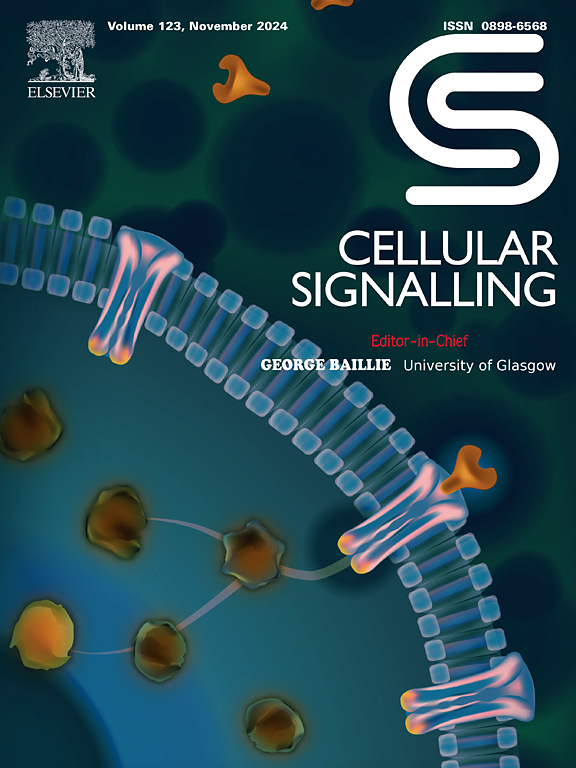EOGT敲低通过HEY1调控SLC7A11促进铁下垂,抑制肝细胞癌增殖。
IF 4.4
2区 生物学
Q2 CELL BIOLOGY
引用次数: 0
摘要
背景:肝细胞癌(HCC)是癌症相关死亡的主要原因,其特征是复杂的分子结构。EGF结构域特异性O-linked β- n -乙酰氨基葡萄糖转移酶(EOGT)是一种对含有表皮生长因子(EGF)重复序列的蛋白质具有特异性活性的O-GlcNAc转移酶。虽然已知它可能在HCC中起致瘤作用,但确切的机制尚不清楚。诱导铁下垂是索拉非尼等抗癌药物治疗HCC的主要机制。本研究旨在阐明EOGT在HCC中的表达谱及其与铁下垂的关系,并探讨其潜在的分子机制。方法:利用生物信息学资源,探讨EOGT在HCC中的潜在作用。采用裸鼠细胞模型和皮下异种移植模型研究EOGT对HCC细胞行为的影响。通过细胞模型中的RNA-seq、小鼠流体动力学模型、Western blotting、染色质免疫沉淀(ChIP)测序和双荧光素酶报告基因检测来分析HEY1与SLC7A11之间的相互作用,进一步了解其分子机制。采用多个验证步骤来彻底研究这些因素在HCC中铁下垂调节中的作用。结果:我们的研究结果显示,EOGT在HCC中上调,并与预后不良和耐药相关。敲低EOGT可通过下调SLC7A11 (HEY1介导的这一过程)抑制HCC细胞增殖并增强对铁凋亡的敏感性。这些结果通过细胞活力测定、实时荧光定量PCR (qPCR)、Western blotting和双荧光素酶报告基因测定得到证实。结论:EOGT通过调节HEY1-SLC7A11轴促进HCC增殖,抑制铁下垂,提示HCC治疗的潜在靶点。本文章由计算机程序翻译,如有差异,请以英文原文为准。
EOGT knockdown promotes ferroptosis and inhibits hepatocellular carcinoma proliferation by regulating SLC7A11 via HEY1
Background
Hepatocellular carcinoma (HCC) is a leading cause of cancer-related mortality, characterized by a complex molecular landscape. EGF Domain Specific O-linked β-N-acetylglucosamine transferase (EOGT) functions as an O-GlcNAc transferase with specific activity towards proteins containing epidermal growth factor (EGF) repeats. Although it is known to potentially play an oncogenic role in HCC, the exact mechanisms remain unclear. Induction of ferroptosis is a primary mechanism by which anticancer drugs such as sorafenib treat HCC. This study aimed to elucidate the expression profile of EOGT in HCC and its relationship with ferroptosis, as well as to investigate the underlying molecular mechanisms.
Methods
Utilizing bioinformatics resources, we explored the potential role of EOGT in HCC. The effects of EOGT on HCC cell behavior were examined using cell models and subcutaneous xenograft models in nude mice. Further insights into the molecular mechanisms were obtained through RNA-seq in cell models, hydrodynamic modeling in mice, Western blotting, chromatin immunoprecipitation (ChIP) sequencing, and dual-luciferase reporter assays to analyze the interaction between HEY1 and SLC7A11. Multiple validation steps were employed to thoroughly investigate the roles of these factors in the regulation of ferroptosis in HCC.
Results
Our findings revealed that EOGT is upregulated in HCC and correlates with poor prognosis and drug resistance. Knockdown of EOGT inhibited HCC cell proliferation and enhanced sensitivity to ferroptosis by downregulating SLC7A11, a process mediated by HEY1. These results were confirmed by cell viability assays, quantitative real-time PCR (qPCR), Western blotting, and dual-luciferase reporter gene assays.
Conclusions
EOGT promotes HCC proliferation and inhibits ferroptosis by modulating the HEY1-SLC7A11 axis, suggesting a potential therapeutic target for HCC treatment.
求助全文
通过发布文献求助,成功后即可免费获取论文全文。
去求助
来源期刊

Cellular signalling
生物-细胞生物学
CiteScore
8.40
自引率
0.00%
发文量
250
审稿时长
27 days
期刊介绍:
Cellular Signalling publishes original research describing fundamental and clinical findings on the mechanisms, actions and structural components of cellular signalling systems in vitro and in vivo.
Cellular Signalling aims at full length research papers defining signalling systems ranging from microorganisms to cells, tissues and higher organisms.
 求助内容:
求助内容: 应助结果提醒方式:
应助结果提醒方式:


